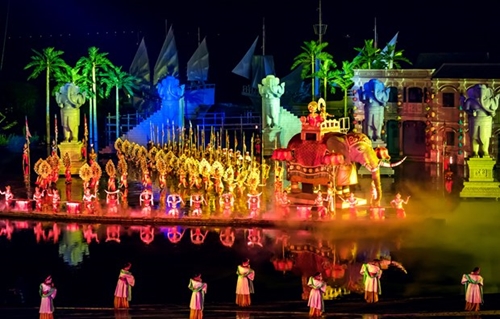The development of tourism associated with the preservation and promotion of cultural heritage values has long been a long-standing policy of the Vietnamese Party and State. Even under the Strategy for the Development of Cultural Industries in Vietnam until 2020 with a vision to 2030, cultural tourism is affirmed as one of the cultural industries that requires investment and development. The strategy targets that cultural tourism will account for 15-20% of the total revenue of USD 40 billion from tourism by 2030.
    |
 |
|
At a music show in Hoi An |
In recent years, Vietnam has been honored with the prestigious World Travel Awards (WTA) as a top world heritage destination, a leading cultural destination in Asia, and a top culinary destination in Asia. Many cultural tourism products and destinations with world cultural heritages have become significant highlights on the Vietnamese tourism map, such as the Trang An Scenic Landscape Complex in Ninh Binh, the Complex of Hue Monuments in Thua Thien Hue, My Son Sanctuary and Hoi An Ancient City in Quang Nam.
However, experts said Vietnam has yet to have quality cultural tourism products that match its potential.
Dr. Nguyen Anh Tuan, Director of the Institute for Tourism Development Research, said cultural tourism products in Vietnam are often repetitive, limited in quality, lacking creativity and differentiation among regions and localities nationwide.
Vu Van Tuyen, CEO of Travelogy, said there are three major ways to increase the level of creativity in the building and marketing of cultural tourism products, including reproduction, simulation, and narration which aim to create more impressions and deeper experiences for tourists regarding the type of tourism product, through the use of imagery, models, stories, and historical cultural legends, whether real or fictional, in a reasonable manner.
In order to effectively tap a tourism product, the involvement of the destination, local authorities, cultural and historical experts and tour agents is needed, he said.
From a macro perspective, Tuan said in order to develop cultural tourism, it is essential to pay special attention to conservation and restoration efforts to promote the values of cultural heritages, shaping and building the brand of each locality and the nation based on existing cultural foundations to attract the attention of investors and tourists both at home and abroad.
It is also important to upgrade tourism-related infrastructure and technical facilities, particularly in regions rich in cultural tourism resources but with slower socio-economic development. Additionally, it is crucial to uphold the role of the community and community culture in tourism development, ensuring a balanced benefit from tourism activities for the community, he said.
Source: VNA